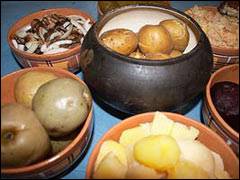Christmas fast begins in Ukraine

![]()
 Great Christian feasts always are accompanied with pre-feast fast. In the end of the year, there is a long fast, Pylypivka before Christmas. In the Ukrainian Orthodox and Greek Catholic churches, it begins on 28 November (according to the new style) and lasts until 6 January.
Great Christian feasts always are accompanied with pre-feast fast. In the end of the year, there is a long fast, Pylypivka before Christmas. In the Ukrainian Orthodox and Greek Catholic churches, it begins on 28 November (according to the new style) and lasts until 6 January.
In the Roman Catholic Church it begins on 2 December and lasts until the Eve of Christmas, the 24th of December. In the Roman Catholic Church, this period is called Advent, the time of joyful anticipation and preparation for the advent of the Savior. The Advent is divided into two parts: the first one begins with the first day and is dedicated to the Second Advent of Christ, the second one lasts from 17 to 24 December and is the time of direct preparation for the feast of Christmas.
Christmas as well as Easter belong to the greatest feasts of the year, therefore the fast before Christmas was observed after the pattern of the Easter fast and even is called Fast of Forty Days.
Fr. Yulian Katrii in his book “Know your Rite,” notes that the cradle of this fast is Gaul (now, France). The preparation fast in these territories is mentioned in the 5th century. Bishop Gregory of Tours (+ 594) said that St. Perpetuus (+ 491), the Bishop of Tours fasted on Mondays, Wednesdays and Saturdays starting from the day of St. Martins (11 November). The Council of Tours II (567) decreed that monks should fast each day in December until Christmas. Later the fast was introduced to Rome and Italy and then to England.
The Christmas fast in the west later was given the name Advent, that is coming of Christ to the world. In the beginning, the word “advent” meant the very Feast of Christmas and later it began to mean the time before Christmas. In the 9th c., the first Sunday of the Advent became the beginning of the Church Year in the West.
In the west, the Christmas fast in the 6th century became generally accepted, whereas in the East, it was only introduced at that time. The Christmas fast, which began on 14 November, was first mentioned by the Coptic Calendar in the 8th century. In the 9th century, it became generally accepted in the East.
In Rus, before the Mongol age, there were three other fasts in addition to the Easter Lent. Metropolitan Heorhii of Kyiv wrote in “Bilecheskii Statutes” that these fasts began on the days when they begin now. He calls the Christmas fast Pylypivka, which means that it began on 27 (14) November, the day of St. Pylyp. He prescribes for Pylypivka the same fast as for Petrivka: eating once a day without milk and meat with fish allowed on Saturdays and Sundays. Metropolitan Maksym of Kyiv (1283-1305) calls the Christmas Fast the Fast of Forty Days.
Today, the Church for various reasons, made the fasts, which were strict in the past, less strict and left them to the good will of the faithful. But, as Fr. Yulian Katrii stresses, this does not mean that we are not obliged to practice the spirit of sacrifice, penance and fast. The time of fasting is first of all a time of purification of the soul and preparation of a person for celebration of the light Christian feast, particularly, the coming of Christ to the world.
Fasting of Christians is accompanied with frequent prayer and taking of the Holy sacraments, which Christians should regularly practice at non-fasting times also.
The main aim of the fast, established in the early centuries of Christianity, is the spiritual purification of a person. Therefore, fasting is abstention not only from lactinia but also from sinful thinking, bad habits in order to meet Christmas with a pure heart Without prayer and repentance, fasting can become just a diet.









